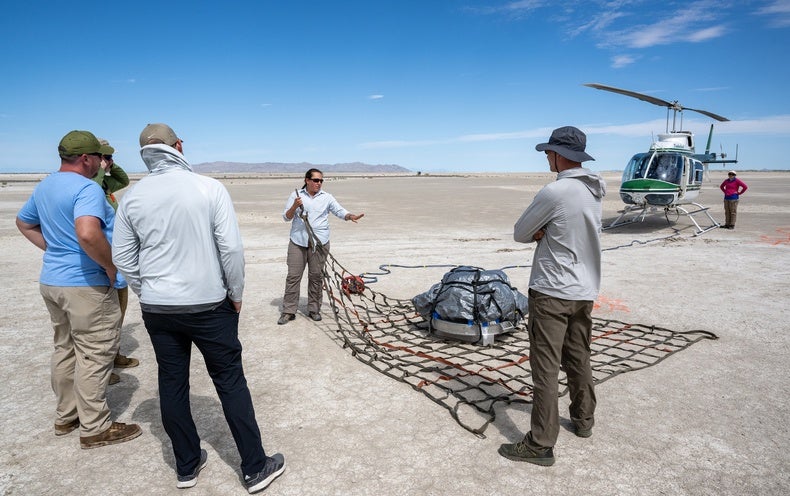Within the historic quest to deliver samples from throughout the photo voltaic system again to Earth, one of the best mantra for achievement could also be a easy, acquainted phrase: “observe makes good.”
At the least, that’s the sensation from current dry runs of the grand finale of NASA’s OSIRIS-REx, an acronym for the megamouthful Origins, Spectral Interpretation, Useful resource Identification, Safety-Regolith Explorer. Launched in September 2016, OSIRIS-REx is the primary U.S. mission to snare a pattern from an asteroid. In October 2020 the spacecraft dutifully gathered bits and items of the area rock Bennu, an historic rubble pile of various leftovers from the early days of the photo voltaic system’s creation about 4.5 billion years in the past. Now, it’s en route again to Earth, searching for to return that treasured payload safely to terra firma in an exciting act of interplanetary derring-do set to unfold within the early-morning hours of September 24.
On the coronary heart of this effort is probably 250 grams (nobody is aware of precisely how a lot but) of extraterrestrial freight that was grabbed from Bennu utilizing the novel Contact-and-Go Pattern Acquisition Mechanism (TAGSAM), which additionally shops the pattern. That {hardware} is cocooned inside a sample-return capsule that OSIRIS-REx will solid off with split-second precision because it zooms by Earth. After enduring a fiery reentry focused for the Division of Protection Dugway Proving Floor within the Utah Check and Coaching Vary, roughly 70 miles west of Salt Lake Metropolis, the capsule ought to sluggish its descent by way of parachute and contact down someplace inside that distant swath of excessive desert—presuming, after all, that every thing proceeds in accordance with plan.
To arrange for all believable situations, nominal and in any other case, in late June and once more early this month a cadre of scientists, engineers and different assist personnel gathered for high-fidelity, step-by-step simulations of the OSIRIS-REx capsule retrieval and transport to a mock clear room.
June’s dry run was organized by Lockheed Martin—which constructed TAGSAM, the return capsule and OSIRIS-REx—and occurred on the firm’s campus in Littleton, Colo., beneath the watchful eyes of planners scribbling notes for different missions. Foremost amongst these is the multiagency Mars Pattern Return program—an much more formidable and fraught multibillion-dollar effort that seeks to ship Pink Planet supplies again to the Earth within the 2030s.
Fringe of the Ellipse
There are good causes for the OSIRIS-REx group to be on edge. The identical stretch of Utah panorama that can form its mission’s destiny in a couple of months’ time has already been witness to each calamity and victory.
In September 2004 NASA’s Genesis spacecraft, toting samples of photo voltaic wind, didn’t deploy its parachutes after atmospheric reentry. Due to improperly put in parachute-deployment switches, the high-speed affect led to a severely banged-up capsule and the contamination of its prized cargo. Fortunes turned lower than two years later, in January 2006, when NASA’s Stardust mission efficiently parachuted to Earth a capsule sprinkled with particles spewed by Comet P/Wild 2, offering a wealthy bonanza of fabric for subsequent laboratory scrutiny.
Important work has gone into avoiding a “Genesis-level” occasion, says Richard Witherspoon, lead of Lockheed Martin’s OSIRIS-REx ground-recovery operations. “We’re assured that received’t occur once more. We perceive the technical challenge that occurred on Genesis. We’ve got achieved intensive testing on OSIRIS-REx to be sure that wouldn’t occur.” The design of the OSIRIS-REx capsule and restoration procedures are primarily based on Stardust heritage, he provides.
Credit score: Jen Christiansen; Sources: “OSIRIS-REx, Returning the Asteroid Pattern,” by Thomas M. Ajluni et al. IEEE Aerospace Convention Paper, March 2015; and “OSIRIS-REx: Pattern Return from Asteroid (101955) Bennu,” by Dante S. Lauretta et al., in Area Science Evaluations, Vol. 212; August 2017 (main references)
Nonetheless, Witherspoon notes that the touchdown carries unavoidable dangers—even at a sluggish 10 miles per hour beneath parachute. An unfortunate landfall on a rock might breach the outer a part of the capsule’s warmth protecting protect—though that state of affairs shouldn’t be anticipated to compromise the sample-carrying canister itself. Different less-than-ideal circumstances would contain discovering the capsule the wrong way up or retrieving it from a mushy mud puddle fashioned from uncommon desert rainfall.
The capsule’s drop space in Utah is an ellipse that measures 36 by 8.5 miles. On the nail-biting day, it is going to be ringed by 4 helicopters prepared to move a dozen or extra restoration group members as soon as the capsule’s landing website is pinpointed inside. A techniques security officer will probably be among the many first on the scene. They are going to examine for any breaches or outgassing from the capsule to guarantee each the realm and the payload are secure and sound for a soon-to-follow entourage of personnel.
“We’ve got created circumstances that have been considerably worse simply to be sure that we knew the best way to deal with any situation,” Witherspoon says. “Weexpect to have the capsule again to the clean-room processing space inside two hours of it being on the bottom and to have it on nitrogen purge inside one other two hours.”
That nitrogen flush will probably be achieved to guarantee exterior air doesn’t pollute the samples previous to relocating the capsule and its high-value contents to NASA’s Johnson Area Middle in Houston, Tex. As soon as there, the capsule will probably be totally disassembled, with elimination of TAGSAM and the load of asteroid goodies occurring in freshly up to date clean-room amenities.
Whereas the June dry run had restoration group members training the dealing with of a mock return capsule and supply to a simulated clear room, the second session (which befell from July 18 to twenty) was on location within the space of the Utah desert the place the asteroid samples will arrive. The latter session included helicopter coaching for restoration group members tasked with airlifting the pattern capsule.
“The Second of Huge Emotional Reduction”
Dante Lauretta, OSIRIS-REx’s principal investigator on the College of Arizona, reels off an extended checklist of attainable ache factors whereas observing June’s restoration rehearsal. Essentially the most regarding ones are people who any dry run’s meticulous planning and improvisational actions can’t correctly deal with. At first, the capsule have to be autonomously launched above Earth—a fancy process requiring the reducing of cables and detonation of explosive “maintain down” bolts. Inside batteries have to get up and provide energy. Parachutes packed means again in 2016 have to unfurl. An issue anyplace in that prolonged chain will simply end in TAGSAM being crushed like a beer can after a free-falling, high-speed nose-dive into the desert ground.
Lauretta isn’t actually frightened, nonetheless. “Fairly truthfully, I put us at 99 % probability of mission success,” he says, underscoring all of the painstaking prelaunch testing of {hardware} and spacecraft efficiency so far. Even so, “it is going to be the second of huge emotional aid to see our parachute open and that pattern drifting safely right down to Earth. Then I do know we did it. At that time it’s all gravy.”
Even when OSIRIS-REx’s capsule suffers a Genesis-like arduous touchdown, Lauretta and others on his group are assured they may nonetheless pull off some nice science. “What we’re frightened about is defending the asteroid pattern from Earth contamination,” says Anjani Polit, OSIRIS-REx’s mission implementation techniques engineer on the College of Arizona. “All the hassle, the numerous rehearsals and operational readiness assessments which might be larger and better constancy, that’s labored extraordinarily nicely.”
Prime the Pumps
All of the tender loving care and classes discovered from OSIRIS-REx are feeding into NASA’s main planetary-science endeavor for the 2030s: the Mars Pattern Return (MSR) enterprise.
Specimens of the Pink Planet are additionally destined for supply to the Utah Check and Coaching Vary. However there are variations, principally pushed by the hot-button challenge of whether or not life-forms may exist on Mars—and thus doubtlessly within the retrieved samples. Something apart from a nonzero prospect of hauling viable extraterrestrial organisms to Earth and introducing them to our biosphere raises the specter of what “planetary safety” specialists name “backward contamination.”
As now deliberate, the cone-shaped MSR Earth entry car will fall by way of Utah’s skies with out a parachute, ruggedized to endure the wallop of affect with the high-desert hardpan, in addition to any subsequent rolling and bouncing. From there, a restoration group will deal with it as doubtlessly hazardous materials, enclosing it in a protecting container after which transporting it to a yet-to-be-built isolation facility, possible positioned exterior of Utah.
For MSR, “we’re very a lot leveraging quite a lot of the work that’s being achieved on OSIRIS-REx,” says Nick Benardini, NASA’s planetary safety officer. “We’re increase the mandatory ability units for what’s wanted,” with public security and excessive pattern integrity for scientific evaluation because the driving targets.
The method is difficult by MSR’s inherently worldwide nature—each NASA and the European Area Company are fleshing out the endeavor. And even on the U.S. aspect, Benardini explains, the mission is so advanced that NASA should rigorously interact with a slew of interagency companions, from the Facilities for Illness Management and Prevention and the Federal Emergency Administration Company to the Division of Transportation and the Division of Homeland Safety.
“OSIRIS-REx permits us to prime the pumps,” Benardini continues, to get procedures, coaching and pattern integrity strategies labored out as early as attainable. “It’s permitting all people to have a Mars Pattern Return mindset.”



